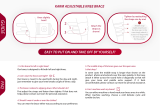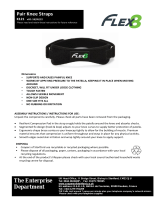Page is loading ...

Layer 1
Comfort Foam Layer
• Apply this layer
with the foam
side against the
skin, using just
enough tension
to conform to
the shape of the
leg with minimal
overlap.
• Cover the skin
with as thin a
layer as possible
with no gaps.
• When skin folds
(aprons) are
present, use
pieces of comfort
foam layer folded
with foam side
out to separate
them.
Step 1: With the foot in a 90˚
dorsiexed position, start the
application with a circular winding at
the base of the toes, beginning at the
fth metatarsal head. Beginning at the
fth toe provides neutral, comfortable
foot alignment.
Step 2: The second circular winding
should come across the top of the foot
so that the middle of the bandage width
approximately covers the articulating
aspect of the ankle joint. Bring this
winding around the back of the heel
and lay it over the top of the foot where
it overlaps the underlying material.
Step 3: Cut the wrap and gently
press into place. The posterior
plantar surface of the foot is not
completely covered.
Step 4: With minimal overlap, proceed
up the leg in a spiral technique with just
enough tension to conform smoothly
along the contours. If the bandage spiral
does not conform with minimal overlaps,
the bandage may be cut to redirect the
application. Continue up the leg to cover
all skin with as thin a layer as possible.
NOTE: Individual windings may be
used for highly contoured legs.
Step 5: The top of the bandage should
end just below the bular head, or two
ngers width below the crease at the
back of the knee.
Step 6 : Apply light pressure to
the comfort layer with your hands.
This helps to mold the bandage to
the patient. The end of the comfort
foam layer may be secured with
tape.
Layer 2
Compression Layer
• Apply the material
at full stretch.
• Hold the roll
close to the limb
throughout the
application for
controlled, even
compression.
• If “bulges” are
noted after the
application,
apply additional
compression layer
until the limb
appears smooth.
Step 7: With the foot in a 90˚ dorsiexed
position, start the application with a
circular winding at the base of the toes,
beginning at the fth metatarsal head.
Step 8: Complete
two or three
gures of eight
around the ankle
ensuring that
the entire heel is
covered.
Step 9: Proceed up the leg with 50%
overlaps at full stretch, ending the
application approximately 2 to 3 inches
below the ending of the comfort layer.
This will allow the comfort layer for the
knee and thigh to overlap with the lower
leg comfort layer for secure cohesion.
Step 10: As
you end the
application, apply
light pressure and
cut o the excess
material.
• Keep the leg supported in a relaxed
position throughout the entire
application.
• Apply the bandage to the lower leg
with the patient sitting or lying back
comfortably, and then have the
patient stand to apply the upper
leg bandage.
• If a wound is present, foam dressings
are most eective for managing
exudate.
• Use a 4 inch kit for the lower leg and a
6 inch kit to cover the knee and thigh.
Materials &
Positioning
3M
™
Coban
™
2 Layer Compression System Full Leg Application
Below the Knee

• Apply this layer with the
foam side against the skin,
using just enough tension
to conform to the shape
of the leg with minimal
overlap.
• Cover the skin with
as thin a layer as possible
with no gaps.
• When skin folds (aprons)
are present, use pieces of
comfort foam layer folded
with foam side out to
separate them.
Step 11: Reposition the
patient to a standing
position. Place a bandage
roll under the heel to
support the knee in a
exed, relaxed position.
Step 12: Center the comfort layer to
ensure that the middle of the bandage is
positioned over the articulating surface
and crease of the knee. Make one
circular winding.
Step 13: With a circumferential winding,
take the bandage down to minimally
overlap the below knee application,
then bring the bandage up towards
the thigh.
Step 14: Proceed to the top
of the leg. Keep the overlaps
as minimal as possible.
Step 15: Apply two full
circular windings of comfort
foam layer at the top of the
leg to prevent edge roll. As
you end the application,
apply light pressure and cut
o the excess material. The
end of the comfort foam layer
may be secured with tape.
Knee and Above the Knee
Critical & Chronic Care Solutions Division
3M Health Care
2510 Conway Avenue
St. Paul, MN 55144
USA
1-800-228-3957
3M.com/c3sd
3M and Coban are trademarks of 3M.
Please recycle. Printed in U.S.A.
© 3M 2013, 2015. All rights reserved.
70-2011-5425-2
Layer 1 Comfort Foam Layer
• Apply the material
at full stretch.
• Hold the roll close to
the limb throughout the
application for controlled,
even compression.
• If “bulges” are noted after
the application, apply
additional compression
layer until the limb
appears smooth.
Step 16: Begin the compression layer
application with a 50% overlap of the below
knee bandage. Cover the knee using spiral
windings or gures of eight as needed
to conform. Ensure that the center of the
bandage is in the center of the popliteal
crease and centered over the patella.
Step 17: Proceed up the leg with spiral
windings with 50% overlap at full stretch.
This ensures at least two layers of
compression material.
Step 18: Stop the compression
layer application at top of leg.
Apply light pressure and cut o
the excess material.
Step 19: Mold the entire
application to conform to the
anatomy.
Layer 2 Compression Layer
Bandage Removal
Dipping the scissor tips
into body lotion allows
for comfortable and easy
bandage removal.
3M
™
Coban
™
2 Layer Compression Systems
NOTE: Refer to the Instructions for Use for complete information
related to the use of 3M
™
Coban
™
2 Layer Compression Systems.
/




